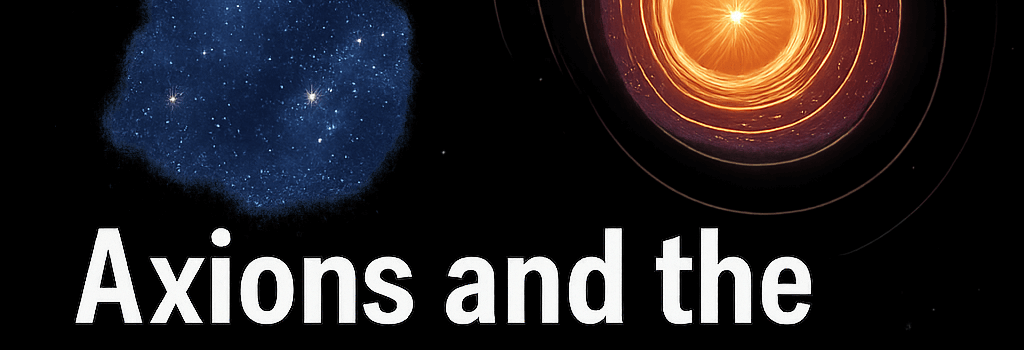Axions and the Dark Matter Puzzle

Why Dark Matter Demands a New Particle
The dark matter hypothesis arises from multiple independent observations: galaxy rotation curves, gravitational lensing, cosmic microwave background anisotropies, and Big Bang nucleosynthesis constraints. Traditional luminous matter accounts for only ~15% of the total mass–energy budget of galaxies and clusters. ΛCDM simulations agree with large-scale structure but overpredict small-scale substructure and cuspy profiles at galactic cores. Consequently, the astrophysics community accepts that ~85% of non-baryonic dark matter must exist as a new weakly interacting component.
Weakness of WIMPs and the Rise of Axions
Weakly Interacting Massive Particles (WIMPs) were long the frontrunners, motivated by supersymmetry and thermal freeze-out. However, decades of direct-detection campaigns—LUX-ZEPLIN (LZ), XENONnT, PandaX—have pushed exclusion limits down to 10⁻⁴⁸ cm² for 30–50 GeV/c² masses. With no signal above background, large swaths of the canonical WIMP parameter space are ruled out at the 90% confidence level.
Theoretical Origin of Axions
Originally proposed in 1977 by Peccei and Quinn to solve the strong CP problem in quantum chromodynamics (QCD), axions naturally enforce charge–parity symmetry via a dynamical field. Frank Wilczek and Gerard ’t Hooft identified the resulting pseudo-Nambu–Goldstone boson, now called the axion. The axion field scales with the Peccei–Quinn symmetry breaking scale fa, leading to a mass ma≈5.7 μeV(1012 GeV/fa), intimately linking astrophysical observables to QCD theory.
Ultra-Light Dark Matter and Bose–Einstein Condensates
Unlike WIMPs, axions can be ultra-light (10⁻⁶–10⁻²⁰ eV). Their de Broglie wavelengths λ=ħ/(mav) extend from sub-meter to kiloparsec scales. At cosmological densities, axions can form coherent Bose–Einstein condensates, suppressing small-scale structure via quantum pressure. This “fuzzy” dark matter paradigm resolves core–cusp problems and the missing satellites issue by introducing a characteristic Jeans scale of order kiloparsecs.
Experimental Frontiers: Cavity Haloscopes and Beyond
The Axion Dark Matter eXperiment (ADMX) uses a tunable microwave cavity immersed in an 8 T superconducting magnet and cryogenically cooled to ~100 mK. With a loaded quality factor Q>10⁵ and system noise temperatures below 2 K, ADMX recently excluded DFSZ axions in the 2.66–2.81 μeV range at 90% confidence. Complementary efforts include HAYSTAC, which employs squeezed-vacuum states to reduce quantum noise, and ORGAN, targeting higher mass windows (50–200 μeV).
Recent Experimental Updates
- CASPEr: Uses NMR techniques to probe axion-induced nuclear spin precession at frequencies from Hz to kHz, setting new limits on axion–nucleon couplings of gaNN<10⁻¹⁰ GeV⁻¹.
- MADMAX: A dielectric haloscope under construction at DESY, utilizing layered dielectric disks to enhance axion–photon conversion in the 40–400 μeV mass range with an estimated sensitivity of gaγγ<10⁻¹² GeV⁻¹.
- CAPP (Korea): Commissioned a 12 T “brushless” magnet with a 30 cm bore, enabling cavity volumes up to 5 L and exploring ma=1–10 μeV parameter space.
- Stellar Observations: Analysis of horizontal branch stars in globular clusters by the IAXO collaboration places constraints on axion–photon coupling gaγγ<4×10⁻¹¹ GeV⁻¹.
Theoretical Parameter Space and Model Variations
Beyond the minimal QCD axion, axion-like particles (ALPs) arise in string compactifications with decay constants spanning 10⁸–10¹⁸ GeV. Such models predict a “string axiverse,” where multiple ALPs contribute to dark matter or dark radiation, detectable via oscillating forces in precision experiments like torsion balances or atomic interferometry (e.g., MAGIS-100).
Cosmological Simulations with Fuzzy Dark Matter
“Fuzzy dark matter models demonstrate remarkable agreement with observations of dwarf galaxy cores while preserving large-scale structure,” says Dr. Ana Lopez, a computational astrophysicist at the University of Cambridge.
High-resolution numerical simulations implement Schrödinger–Poisson solvers to evolve axion density fields. They reproduce solitonic cores with density profiles ρ(r)∝[1+(r/rc)²]⁻⁸, where rc∼1 kpc for ma≈10⁻²² eV. These features match rotation curves of low-surface-brightness galaxies without invoking baryonic feedback mechanisms.
Future Outlook: Next-Generation Searches
- Quantum Sensors: Cavity arrays employing Josephson parametric amplifiers aim for noise temperatures <50 mK, enabling scanning speeds 10× faster than current haloscopes.
- Directional Detection: The MADMAX collaboration explores phased-array reflectors to infer axion wind directionality from the relative phase of emitted photons.
- Gravitational Probes: Pulsar timing arrays (NANOGrav, IPTA) search for stochastic signals from axion miniclusters or superradiant instabilities around spinning black holes, providing indirect tests of ma=10⁻¹⁷–10⁻¹² eV.
Conclusion
Although WIMPs have dominated dark matter research for decades, the axion has emerged as a compelling alternative, bridging particle physics, astrophysics, and cosmology. The convergence of theoretical developments, advanced experiments, and astrophysical observations in the next five years promises to verify or exclude large swaths of axion parameter space. Whether through a faint microwave photon, an oscillating nuclear spin, or a telltale astrophysical signature, the quest to clean up the messy business of dark matter continues at the frontiers of science and technology.